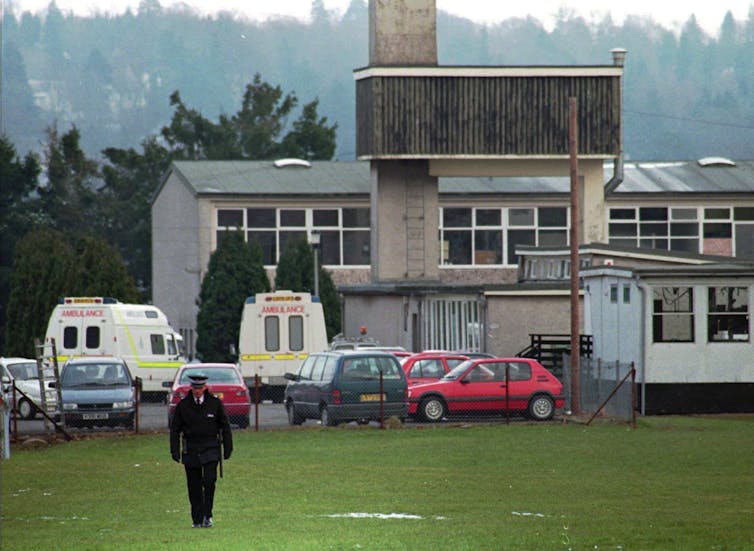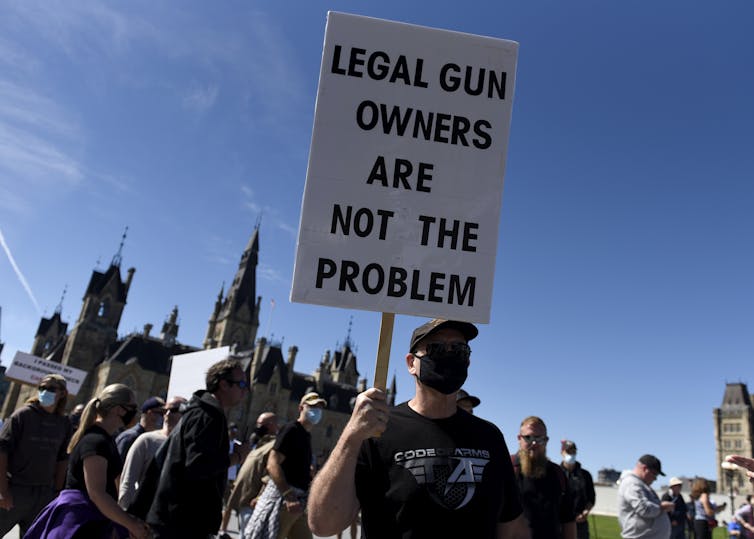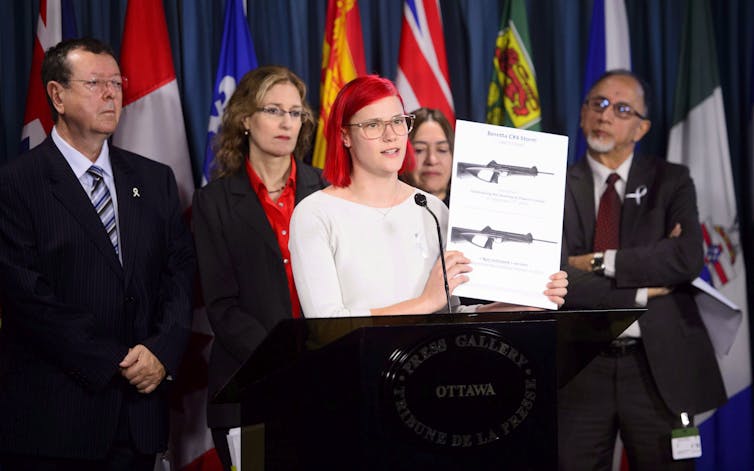
The Canadian government has tabled new legislation to strengthen the screening process of individual firearm owners, institute a mandatory buyback of banned semi-automatic military style firearms and to ban the sale, import and transfer of handguns.
This new legislation, Bill C-21, is a potential game-changer, but it’s been a long time coming. Calls for a ban on semi-automatic, military-style weapons date back to the Montréal massacre more than 30 years ago.
Read more: Montréal Massacre anniversary: The media must play a key role in fighting femicide
Anne McLellan, then the Liberal justice minister, promised a ban on the gun used in that tragedy — the Ruger Mini 14 — as well as the notorious AR-15, but it never came to pass.
In 2005, when Liberal Leader Paul Martin promised a ban on handguns as he ran for re-election, there were about 350,000 restricted weapons in Canada. Now there are more than a million. The proliferation of handguns is partly the result of the relaxation of laws, but even more the lack of implementation of the laws that exist.
While some people are rejoicing about the new legislation, others are asking why it took so long.
The simple answer? The gun lobby. But perhaps there’s more to it than that.
More guns, more gun deaths
The evidence is clear — in industrialized countries where there are more guns, there are higher rates of firearms crime and gun-related deaths.
A comparison of Canada, the United Kingdom, Australia and the United States is instructive: While rates of homicide without guns are comparable (although the U.S. is slightly higher), rates of homicide with guns are dramatically different.
The U.K. has a rate per capita of gun homicides that is one-tenth of Canada’s. There were just 33 gun murders in the U.K. in 2019. In Canada in 2020, police reported 277 firearm homicides.
An important difference about the U.K.? It banned handguns after the Dunblane massacre in 1996 that left 16 young schoolchildren dead.

While mass shootings can occur in countries with strict laws, they occur far less frequently. The U.K. rarely sees them. Canada has about one a year. The United States had more than 600 in 2021 and has seen more than 250 this year, leaving hundreds dead and injured. In 2020, almost 20,000 Americans were murdered with guns.
Rural rates of gun violence
Despite the rhetoric about gun control being an urban or gang-related issue, Statistics Canada data shows rural rates of gun crime are higher in most provinces. Rates of domestic homicides, murders of police officers and suicide are also generally significantly higher in rural areas and the west.
Gun advocates complain that stricter gun laws punish law-abiding gun-owners. But handguns and semi-automatic military-style assault weapons are not used for hunting or by farmers for legitimate purposes.

While smuggled handguns play a role in the illegal network of drugs and human trafficking, they are not the entire problem. Legal handguns are often stolen, illegally sold and diverted. Many firearms recovered in crime in Canada that have been traced back by authorities reportedly came from Canadian sources.
The firearms used in the Montréal massacre, at the Québec Islamic Centre and at Dawson College, for example, were all legally acquired.
Others, such as the 2018 Toronto Danforth mass shooting, involved guns that were stolen from legal owners.
American-style arming for self-defence is also rising in Canada. Colten Boushie’s killer, who was acquitted of murder and manslaughter, used a semi-automatic pistol. He also had two handguns he claimed were for “shooting coyotes,” not a legal purpose.
And the links between right-wing and white supremacists groups and the gun lobby are troubling.
Read more: The myth of the Wheat King and the killing of Colten Boushie
Guarding against smugness
The gun control debate has been waged for decades, but we have reached a tipping point. Canadians shouldn’t feel smug watching the carnage unfold in the U.S., where there are almost as many guns as people and more than a third of the firearms are handguns.
Countries in the European Union, Australia, New Zealand and even Switzerland have strengthened their laws in recent years. Canada, meantime, is ranked fourth among countries in the Organization for Economic Co-operation and Development in the rate of gun death.
The Supreme Court of Canada has said unequivocally that there is no American-style right to own guns in Canada, but many politicians echo gun lobby rhetoric about gun owner rights.

Having researched gun violence and advocated for stricter laws for more than 30 years, I argue that the problem has not actually been resistance by the gun lobby and its political allies. There are fewer than 300,000 legal handgun owners in Canada and even fewer collectors of semi–automatic, military-style weapons.
The gun lobby in Canada is remarkably well-resourced and has in the past hijacked the public agenda. But for decades, most Canadians have supported a ban on semi-automatic military-style assault weapons and handguns.
Canadians need to take action
The uncomfortable truth is, however, that unless they are directly affected by gun violence or on the front lines, most Canadians do not actively lobby for gun control. The gun lobby, meantime, will put up billboards, donate to the cause, organize protests and even stalk politicians on the campaign trail.
Politicians are far more likely to hear from gun control opponents than supporters. Public meetings on gun control tend to be swarmed by the gun lobby and many politicians were targeted during the election.
While only one per cent of Canadians own handguns, handgun owners dominated consultations on gun control proposals despite polls showing clearly that the majority of Canadians support gun control.
Canadians will need to take action to ensure the new proposed laws become a reality.
Wendy Cukier is President of the Coalition for Gun Control. She has not received funding for her research on gun control in the last 20 years.
This article was originally published on The Conversation. Read the original article.







